This page is dedicated to the stereo mods I've made in my A4. It is
my hope that you've found this information useful in your own stereo
upgrade endeavors.
My goal with this system was to have a very nice sounding setup,
without breaking the bank, and also maintaining a factory look. There's
nothing like putting a sticker or something flashy on your car so that
robbers will know which one to steal. If you have a Bose system, you
might not be able to duplicate what I did. If you are buying a new car
and are considering the Blose system, DON'T! For the same money you
can build a much better mousetrap yourself.
My car came with the Audi Symphony head unit as all 2000's did. I don't
think the head unit is all that bad really. It has nice features. It works
with my cd changer, and my cell phone (sorta), and the trip computer. Symphony
radios do have a reputation for being possessed by an evil demon that makes them
do funny things. It takes years to get replacement units too. I've been trying
for almost 2 years now myself, but thanks to some clearly staggeringly poor
planning on the part of Audi of America, there are none to be had. Anyway,
the goal here was to replace pretty much everything else in the system and
leave the head unit intact. I had a professional installer do all of the wiring for
me after I decided which components I wanted.
You will need the following things:
- A good component speaker set with 4" midranges and 1" tweeters.
- A decent pair of 6.5" rear coaxial speakers with excellent mid bass performance.
- A 4 channel amp.
- An equalizer is strongly advised.
- An active crossover.
- A subwoofer and box.
- A subwoofer amp or a good bridgeable 2 channel amp.
- 2 AudioLink Line level converters.
- Noise filters.
- A whole mess of wire.
- Someone with experience wiring this stuff and owns an oscilloscope.
For my front doors I listened to a variety of speakers I was very impressed by
the sound quality of the Kicker Resolution RS4.2 set. Unfortunately these aren't
made anymore, and the new model is a little harsh in the upper mid range. Still,
some places have this model in stock, so look around a bit. You can use a 5" speaker
in the door with a special adapter, but you give up quite a lot of clearance in the
door. I decided to stay with the factory sizes. Kicker was nice enough to include
these cute little name badges and some sticky gunk to attach them with. Normally
I wouldn't even use the name plates, but I really like the speakers a lot and
I'm willing to give Kicker some free advertising. Besides, If a crook is seeing
these, he's already broken into my car. I didn't photograph the tweeters as it
looks perfectly stock. You can stash the crossover unit inside the door
wherever there is room.
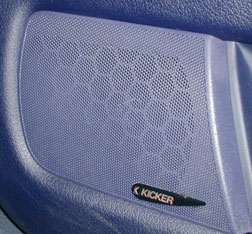

Audi did something very evil when they designed the factory stereo. The rear
deck speakers are self amplified, meaning, if you want to replace them, you
must add an external amplifier of some sorts. Worse, they used a strange high
voltage signal (14V) and thus you must use a line converter to tame the signal
down to an acceptable level. Replacing the speakers is pretty easy. Remove the 3
large bolts in the rear deck under those plastic hooks, fold down the seats, unsnap
the fabric along the front of the deck, and slide it forward while lifting up
gently. Be very careful not to drag the hooks across the speakers or you may
damage them. Here is the bottom of my rear deck speakers. I elected to use the
Infinity Reference 652i system. These have excellent mid bass characteristics
and a good, but not excellent, tweeter. You don't want a super bright mid or
tweeter in the back, as the primary sound stage should be at the front of the
car. However, it's hard to get good mid bass out of those small component systems,
so this was my compromise.
For this application, if you are just looking for better quality sound, and not
bleeding ears, nost any good quality 4 channel 30-50 watt amplifier will do
nicely here. I elected to use the Sony XM-404EQX amplifier because it has all
sorts of built in crossover and EQ controls. It outputs 40W RMS into 4 channels,
more than enough to play uncomfortably loud. Some people like to bash Sony amps
as being low quality, but I measured the performance of this one on my scope and
I found that it met or exceeded all of the listed specs. This amp also has line
level and speaker level inputs, but the speaker level inputs are kinda crappy,
so you're better off using good quality line converters. A 4 channel amp should
be used because you don't want to have a much more powerful and clean amp driving
the rear speakers, than the fronts. Yes, this means that you will have to run
wires from your trunk all the way to the front doors. Trust me, it's worth it.
Also, I have absolutely no problems with heat with the amps mounted under my rear
deck. Every installer I went to made a big fuss about heat when I told them
where to stick it. Even my sub amp only gets a little warm to the touch on
hot summer days and I'm playing it really loud.
No, it's not a firearm or a lead pipe, it's a sound processor. The EQ allows you
to finely adjust the tone of your music to compensate for speaker inadequacies,
car acoustics, road noise, and personal preference. The tone controls on the
Symphony head unit are not that great, and sometimes change spontaniously. With
an EQ in the trunk, you can set the tone controls to flat, and make all your
adjustments back there. It's a pain to set up, but how many people really change
their EQ once it's set up the way they like it? In general, you want the front
speakers to be brighter than the rears. With an EQ like this one, it's very
easy to do just that. I think I'll turn down the 3.2KHz knob the next time I'm back
there though. It's a bit harsh.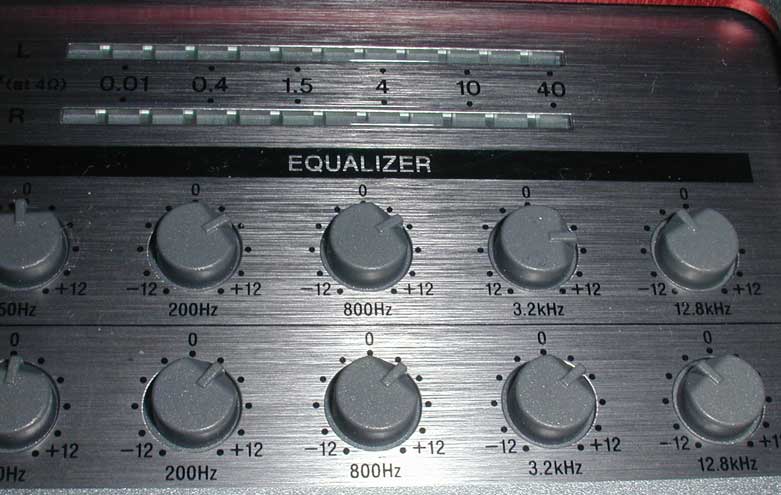
Unlike the crossover on your component system in the front doors, an active
crossover should be thought of more as an electronic signal processor, rather
than a bunch of passive filters that simply block unwated frequencies from
drivers that can't play them. There is a huge variety of active crossover
systems available for this purpose. The ZRX module installed in my subwoofer amp
is set to block all frequencies above 100 Hz fromt he subwoofer's preamp stage.
Kicker makes a huge variety of modules for this docking port.

The Sony amp has a much more sophisitcated crossover setup. It allows me to
set either a low pass or high pass filter independantly on the front and rear
channels. THe knob at the far right is the frequency cut off point for each
channel. As you can see, my front speakers will not be sent any frequencies
below about 140Hz, and my rear speakers will not be sent any frequencies
below 80Hz. This makes all of those speakers last much longer, and the
sound is much cleaner since they are not trying to play notes they weren't
designed to play anyway. Blocking unwated low frequencies will also make
your amplifier run much cooler and more efficiently. You'll note that there
is a little overlap between my sub and my rears. This was tuned to my personal
preference and seemed to give me a very smooth transition between bass and
mid bass.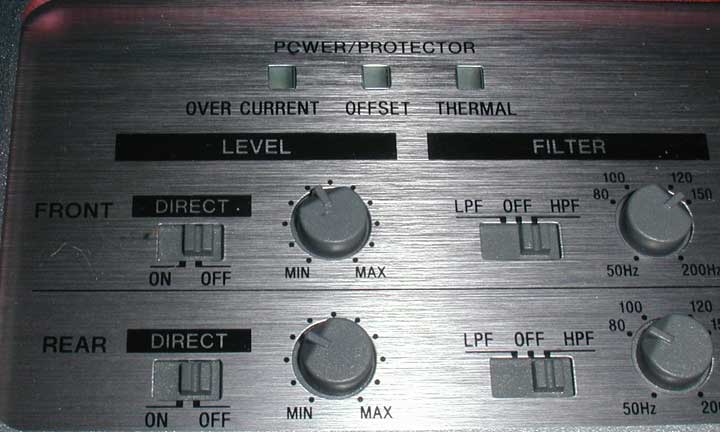
Let's face it. Our factory stereos have pretty lousy bass. It doesn't go very deep
and it's sloppy and boomy. The simple solution is to add a subwoofer. There is
a huge variety of subs to choose from. The Audi A4, however, tends to be rather
boomy by nature, so if you want balanced bass, then go buy the tightest subs
you can find. The Solo-Baric and AlumaPro subs are two great examples. I went
with a simple 8" Solo-Baric setup because it performed very well in my car, and
it was designed to use a .34 cubic foot enclosure, which means I don't have to give
up much trunk space to it. This little wedge just sits innocuously in the corner
of my trunk. I did have to velcro it to the back seat to keep it in place though.
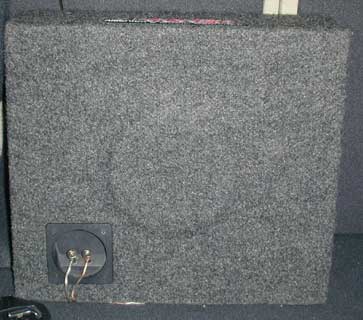
However, don't think that just because it's puny little 8, it can't pound
your internal organs into mush. It plays very very deep, and way louder than I can
stand to listen to. All I need do is ask for it. If the sub faces forward, then
you'll get tighter bass, but at a cost of 3dB in volume. Subwoofer placement
should be determined through some experimentation and personal preference. It
is of vital importance that you pay strict attention to the volumetric specs
provided by the subwoofer manufacturer. The don't just make up a bunch of
technical sounding data to look important. They mean it. Not following
their guidelines will result in sub-optimal performance at best, and driver
damage at worst.
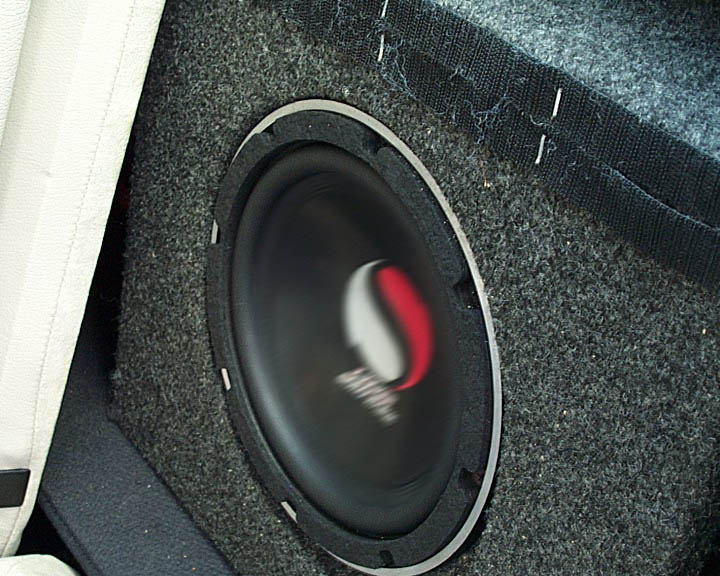
When I say "all I have to do is ask for it", the sub amp is what I ask. This will
most likely be the most expensive single component in your system. You do not
want to take the cheap crappy route here. It is of vital importance to get the
highest quality amp you can afford. I used a Kicker ZR120 in my case. It has
excellent low impedance characteristics, a built in crossover port, a MASSIVE
heat sink, and simple controls. Now all you gotta do is find it some signals.
Oh how I wish it were that simple. You have 2 choices. First is convince someone at
the installer to use the line outputs form your head unit. None of them
will believe you so have a diagram handy. The second choice is to wire a
line converter in parallel with the rear speakers. This is what I ended
up doing.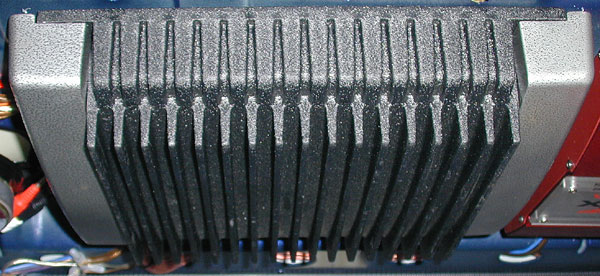
These handy little devices take speaker level signal lines and convert them into
low current signals that the amplifiers will understand. There are a variety of
these on the market, however, I strongly favor the "AudioLink" brand for several
reasons. They are durable, they have a groundable METAL enclosure, they are small,
and they have good quality components. They even come with a good manual. One
of mine is in the trunk where the rear speaker inputs used to be, and the other
one is behind my glove box. Here are the front and rear converters, respectively:
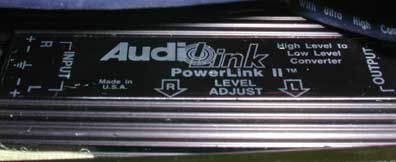

Here is a zoom out of the space behind my glove box to give you a better idea. I
coiled up my excess wires here too. Also it's important to secure these units, or
they might rattle on bumpy roads.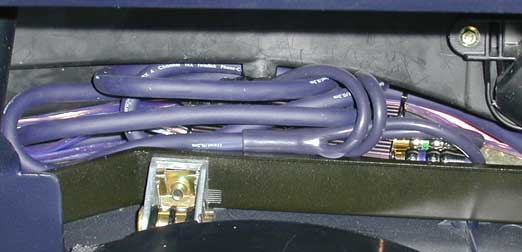
Finally, as a little side note, when putting your glove box back in, be sure to
insert the dampening plunger back into it's tube to keep the door from flopping
open.
When you build your system, don't be surprised if you have a obnoxious whine
that matches the engine RPM. That's what noise filters are for. Most of
them are simple ferrite chokes and are all pretty much the same. You can
drop some serious dosh on active units that digitally process the signal,
but something like that should only be considered after all other hopes have
failed.
Did I say wires? I meant a frigging rat's nest. Jeez there must be a couple
hundred feet of wire in this system. I can't say this enough, unless you
are Mr. Handyman incarnate, pay a professional to do this for you. It'll cost
$200-$300 but it's worth it. You've got power wires, signal wires, speaker wires,
sense wires, and ground wires. Route your wires wherever you can. My car
literally has wires up the wazoo! Here's some for you:

Here's some more coming out of my 4 channel amp.
Keep those ground wires short and be sure to scrape off the paint at the site.
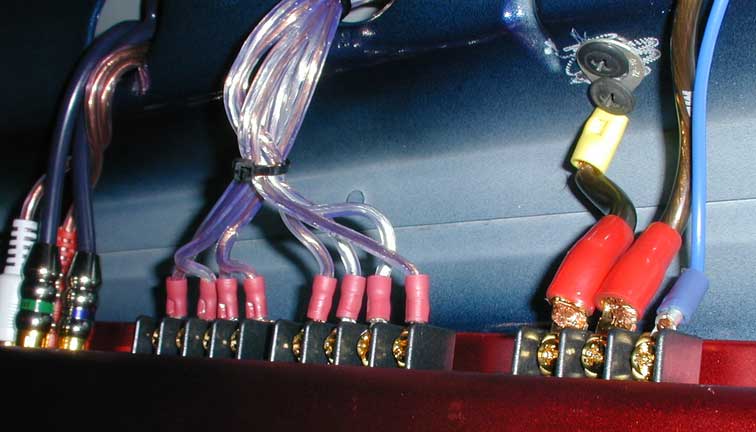
If you attempt this or a similar project, seek professional help. Talk
to a whole bunch of installers and get their opinions before doing anything.
Make lots of calculations for enclosure volumes and power requirements.
Plan how much you want to spend. When you are ready to start, find a friend
who has access to an analog oscilloscope. It doesn't have to be a very modern
one. In fact modern digital scopes sometimes have a hard time locking
on to such a slow signal. If you have noise in the system, a scope can take
a lot of the guesswork out of finding it. It can also detect noise on the
power or ground lines. The scope can quickly tell you what's not causing
your noise problems.
FInally, after all the adjustments are made, sit back and listen to some
beautiful music. Enjoy it. You've earned it.
No pages or images anywhere within my site may be linked to on another web page without my express written consent.

















